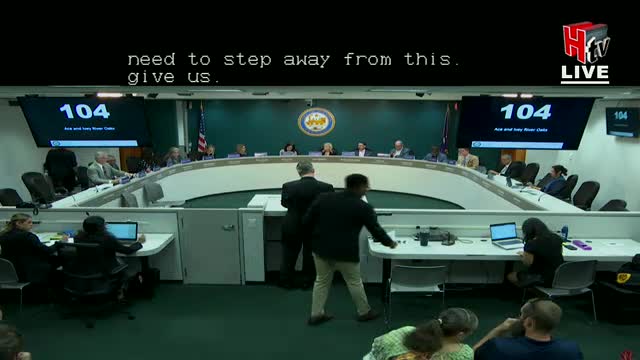Commission defers 'Ace in Ivy' Upper Kirby setback variance after neighbors raise traffic and safety concerns
October 02, 2025 | Houston, Harris County, Texas
This article was created by AI summarizing key points discussed. AI makes mistakes, so for full details and context, please refer to the video of the full meeting. Please report any errors so we can fix them. Report an error »

Houston Planning Commission members on Thursday voted to defer item 104, a replat and variance request for the mixed-use proposal known as Ace in Ivy (River Oaks), after residents and staff raised concerns about traffic, driveway configuration and pedestrian safety.
Staff presentation said the applicant requests variances to allow a 0-foot building line along three public right-of-way frontages instead of the 10-foot setback required by Chapter 42, asserting the development would provide pedestrian enhancements similar to recent reduced-setback projects in the Upper Kirby district. Jeff Butler, presenting for Planning staff, said the application did not yet demonstrate comparable pedestrian benefits or address driveway/design deficiencies and recommended a second deferral to allow revisions.
Resident Jesse Amos, who lives in River Oaks Square townhomes, told commissioners that the site's frontage and proposed driveways would worsen existing congestion on Bammel Lane and create additional safety risks at intersections used by students walking to school. "Bammel Lane already is heavily congested with school traffic and cars cutting through between West Alabama and Westheimer Road," Amos said, urging the commission to retain setbacks that better limit driveway impacts.
Commissioners asked staff and the applicant to address the number and location of driveways, the amount of surface parking at ground level, the thickness/placement of columns that might impede visibility, and whether traffic-calming measures could be coordinated with Public Works. Commissioner Matas moved to defer; Commissioner Victor seconded; the motion carried.
Why it matters: The proposal is in a mixed-use, transit-adjacent neighborhood where setbacks and pedestrian improvements are used to shape ground-floor activity and street safety. Commissioners and staff emphasized the need to align proposed pedestrian improvements with Chapter 42 performance standards and to reduce curb cuts that could worsen pedestrian and vehicular conflicts.
Next steps: The applicant will use the deferral period to revise plans and to provide additional information on driveway locations, pedestrian improvements and column design; staff will review the revised materials and return the item at a later hearing.
Staff presentation said the applicant requests variances to allow a 0-foot building line along three public right-of-way frontages instead of the 10-foot setback required by Chapter 42, asserting the development would provide pedestrian enhancements similar to recent reduced-setback projects in the Upper Kirby district. Jeff Butler, presenting for Planning staff, said the application did not yet demonstrate comparable pedestrian benefits or address driveway/design deficiencies and recommended a second deferral to allow revisions.
Resident Jesse Amos, who lives in River Oaks Square townhomes, told commissioners that the site's frontage and proposed driveways would worsen existing congestion on Bammel Lane and create additional safety risks at intersections used by students walking to school. "Bammel Lane already is heavily congested with school traffic and cars cutting through between West Alabama and Westheimer Road," Amos said, urging the commission to retain setbacks that better limit driveway impacts.
Commissioners asked staff and the applicant to address the number and location of driveways, the amount of surface parking at ground level, the thickness/placement of columns that might impede visibility, and whether traffic-calming measures could be coordinated with Public Works. Commissioner Matas moved to defer; Commissioner Victor seconded; the motion carried.
Why it matters: The proposal is in a mixed-use, transit-adjacent neighborhood where setbacks and pedestrian improvements are used to shape ground-floor activity and street safety. Commissioners and staff emphasized the need to align proposed pedestrian improvements with Chapter 42 performance standards and to reduce curb cuts that could worsen pedestrian and vehicular conflicts.
Next steps: The applicant will use the deferral period to revise plans and to provide additional information on driveway locations, pedestrian improvements and column design; staff will review the revised materials and return the item at a later hearing.
View full meeting
This article is based on a recent meeting—watch the full video and explore the complete transcript for deeper insights into the discussion.
View full meeting
